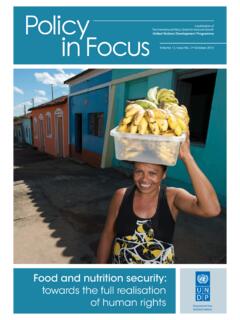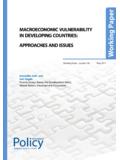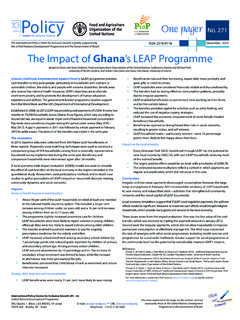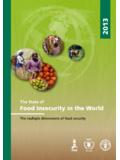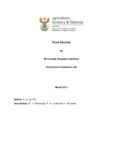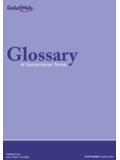Transcription of THE FOOD SECURITY POLICY CONTEXT IN SOUTH …
1 Country Study number 21 April, 2011. THE food SECURITY POLICY CONTEXT . IN SOUTH AFRICA. Josee Koch Independent Consultant and Regional POLICY Adviser for The Wahenga Institute International Centre for Inclusive Growth Copyright 2011. International POLICY Centre for Inclusive Growth United Nations Development Programme International POLICY Centre for Inclusive Growth Esplanada dos Minist rios, Bloco O, 7 andar 70052-900 Brasilia, DF - Brazil Telephone: +55 61 2105 5000. E-mail: URL: The International POLICY Centre for Inclusive Growth is jointly supported by the Poverty Practice, Bureau for Development POLICY , UNDP and the Government of Brazil. Rights and Permissions All rights reserved. The text and data in this publication may be reproduced as long as the source is cited. Reproductions for commercial purposes are forbidden. The International POLICY Centre for Inclusive Growth disseminates these Country Studies to encourage the exchange of ideas about development issues. These studies are signed by the authors and should be cited accordingly.
2 The findings, interpretations, and conclusions that they express are those of the authors and not necessarily those of the United Nations Development Programme or the Government of Brazil. Country Studies are available online at and subscriptions can be requested by email to THE food SECURITY POLICY CONTEXT IN SOUTH AFRICA. Josee Koch*. 1 INTRODUCTION. SOUTH Africa is unlikely to feature at the top of the agenda at any international dialogue on food SECURITY . The country is a net exporter of agricultural commodities and has a high per capita income, even for an emerging economy. There are no tight foreign-exchange constraints, and the country is not landlocked. The innovative constitution entrenches the right to adequate nutrition, and this is the basis of the national Integrated food SECURITY Strategy (IFSS). Taking these features into account, one could easily conclude that food ought to be available and accessible in SOUTH Africa at all times. But is this conclusion correct? The confusing reality is that despite all the favourable indicators and SOUTH Africa's national food -secure status, about 14 per cent of the population is estimated to be vulnerable to food insecurity, and 25 per cent of children under the age of six are reckoned to have had their development stunted by malnutrition (HSRC, 2004).
3 Against this backdrop of contradictions between positive macro trends and indicators and the challenging reality on the ground, the IFSS should be explored further in order to deepen our understanding of POLICY directions and priorities on food SECURITY . The analysis in this report leads to an overall conclusion that the IFSS is an excellent strategy on paper and a relevant framework for different stakeholders, but in reality it lacks implementing power and is therefore not used to its full potential. 2 HISTORICAL OVERVIEW IN RELATION TO food SECURITY . SOUTH Africa presents a unique and important case for understanding food - SECURITY policies. The colonial government of SOUTH Africa established the Native Affairs Department (NAD) in 1926 and embarked on a process of state paternalism. The NAD was tasked with overseeing the African reserves, and therefore with intervening in rural crises such as hunger and famine (Herbst, 1930). Some argue that the development of the NAD was the colonial state's attempt to interconnect free-market principles with the aims of providing relief to and uplifting black people.
4 SOUTH Africa had three official famines during the period 1912 1946, and the official relief provided by the NAD embodied mechanisms of international and domestic trade in the supply of food for vulnerable areas. The NAD's desire to uphold free-market principles influenced its decision to refrain from providing relief in other situations. There were strong nested beliefs within the NAD that being perceived as philanthropists would seemingly * The author would like to express her appreciation for the valuable input gained during the food SECURITY round table in August 2010. Our mutual respect for a free and honest discussion facilitated fruitful sharing of experiences between participants. A special thank you to Mr. Koos van Zyl for sharing his insightful institutional memory and opinions on food - SECURITY -related issues in SOUTH Africa. Josee Koch is an independent consultant and regional POLICY adviser for The Wahenga Institute, based in Johannesburg, SOUTH Africa. The Wahenga Institute (TWI) is a non-profit making body, supporting the role of social protection as a key instrument for poverty reduction, social development and economic growth.
5 2 International POLICY Centre for Inclusive Growth undermine the free market (Wylie, 2001). Paradoxically, despite the state's hardline commitment to the free market principles, the chief patriarch for the NAD knew that he had won political support by being perceived as the giver of gifts, including food assistance and other relief measures. The colonial government that provided relief and assistance through food distribution programmes during three state-defined famines proved both corrupt and often unwilling to provide adequate food relief (Wylie, 2001). In 1948, the Afrikaner National Party (NP) rose to power and this marked the foreshadowing of the government's departure from the paternalist food -relief structures of the colonial regime. The country entered a period of Apartheid, a social and political POLICY of racial segregation and discrimination enforced by white minority governments in SOUTH Africa from 1948 to 1994. The enactment of this POLICY , also known as separate development , was made possible by the 1950 Population Registration Act.
6 This act categorised and labelled all SOUTH Africans in four distinct categories (African Encyclopedia, 2010): Bantu (Black African);. White (White, Caucasian);. Coloured (of mixed race); and Asian (Indians and Pakistanis). After the NP assumed control in 1949, it undertook studies to assess which state relief programmes it could eliminate, particularly aiming to cut allocations of government aid for non-white populations (Greer-Love, 2003). Wylie (2001) has identified several successive NP. acts and policies that significantly undermined the necessary provision of food , particularly in the segregated townships. In a 1949 report on school feeding, the NP concluded that the school feeding scheme was necessary because of the deterioration of physiques among the African children attending school, but resisted it on the grounds that it reduced parental responsibility and caused dependence. As a result, the subsequent NP POLICY pronounced drastic cuts in funding for feeding schoolchildren.
7 Unfortunately, this initial cut in food assistance for schoolchildren marked the first in a series of racist government measures aimed at ending much-needed government food relief. The predominant POLICY framework resulted in widespread hunger among Africans and ultimately compelled the apartheid government to engage, albeit reluctantly, in relief measures in order to avoid projecting the images of crisis conditions internationally (Wylie 2001). The existence of large-scale hunger in SOUTH Africa was confirmed by hunger experts who worked within the apartheid government structures. The government, however, responded to the evidence with disapproval and denied responsibility for, and sometimes even the existence of, hunger (Wylie, 2001). All subsequent cuts in food relief occurred against the backdrop of the more infamous and brutal seizures of local land and of violent resettlement schemes, forcing black Africans to relocate in crowded townships and later to the so-called homelands (Greer-Love, 2003).
8 As an overall consequence of the apartheid government and its policies, before 1994 the majority of SOUTH Africans were denied political rights and excluded from participating in the economic mainstream. The arrival of democracy in 1994 was associated with major political and economic POLICY shifts. On the political front, SOUTH Africa started to design and implement policies that aimed Country Study 3. to reverse past apartheid impacts and that were conducive to democratic consolidation, competitive multi-party engagement and civil participation. SOUTH Africa's current economy includes a modern financial and industrial sector supported by well-developed infrastructure, which operates alongside a significantly large informal subsistence sector. In 2009, continuing the trend of previous years, a large part of the national budget was allocated to job creation, service delivery, enhancing the productive capacity of the economy and supporting the poor (USDA, 2006, cited in Labadarios, 2009).
9 3 POVERTY IN SOUTH AFRICA. Despite the political and economic advances made since 1994, SOUTH Africa continues to experience major challenges of poverty, unemployment and, more recently, steep increases in food and fuel prices, energy tariffs and interest rates. These adverse conditions have placed ordinary SOUTH Africans, already struggling to meet their basic household needs, in an ever more vulnerable situation (Labadarios, 2009). Poverty and food insecurity manifest themselves differently in rural and urban areas. The 2007 UN World Urbanization Prospects highlights an upward trend in urbanisation in SOUTH Africa, and in 2010 it projected that over 30 million people ( per cent) will live in urban areas (UN, 2007). Moreover, the Prospects indicate that the rural annual population growth rate is negative at per cent, compared to positive growth of per cent in the urban areas. Labadarios (2000) concluded that the differences in the presence of hunger by area of residence (urban or rural) and by province were both statistically significant (p< ).
10 Between 1980 and 2009 SOUTH Africa's Human Development Index1 (HDI) rose by per cent annually from to in 2009, giving the country a rank of only 129 of 182. countries, close to the ranking of India (134) and far removed from Brazil (75). Since food insecurity in SOUTH Africa is mainly related to a lack of food purchasing power, as we will discuss in greater detail in the sections below, the Human Poverty Index (HPI) is an enlightening statistic to look into. The HPI focuses on the proportion of people below certain threshold levels in each of the dimensions of the HDI: living a long and healthy life, having access to education, and having a decent standard of living. The HPI value of per cent for SOUTH Africa gives the country a rank of 85 among 135 countries for which the index has been calculated (UNDP, 2009). Table 1 provides an overview of the main indicators for selected countries. TABLE 1. Extract from UNDP's Human Development Report, 2009 for SOUTH Africa, India and Brazil HDI value Life expectancy Adult literacy Education GDP per capita enrolment (PPP in USD).
